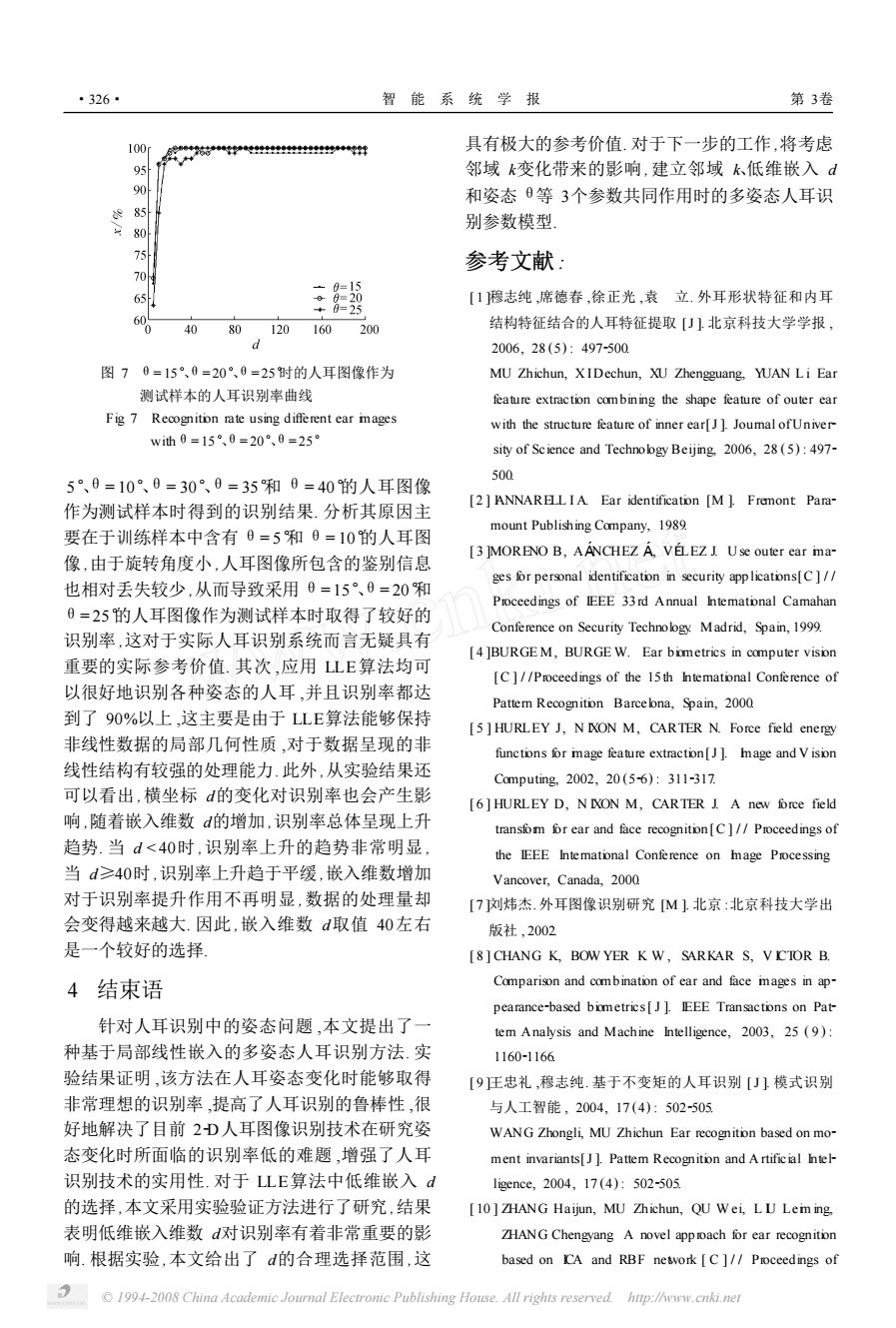正在加载图片...

·326· 智能系统学报 第3卷 100r 件 具有极大的参考价值.对于下一步的工作,将考虑 95 邻域k变化带来的影响,建立邻域k低维嵌入d 和姿态日等3个参数共同作用时的多姿态人耳识 85 80 别参数模型 参考文献: 104 65A 魏 [1穆志纯,席德春,徐正光,袁立.外耳形状特征和内耳 60 0 80 120 160200 结构特征结合的人耳特征提取[J]北京科技大学学报, 2006,28(5):497-500 图70=15°、0=20°、0=25时的人耳图像作为 MU Zhichun,XIDechun,XU Zhengguang.YUAN Li Ear 测试样本的人耳识别率曲线 feature extraction combining the shape feature of outer ear Fig 7 Recognition rate using different ear mages with the structure feature of inner ear[J].Joumal ofUniver with0=15°、0=20°、0=25 sity of Science and Technology Beijing.2006,28(5):497- 500 5°、0=10°、0=30°、0=35和0=40的人耳图像 [2]ANNARELL IA.Ear identification [M ]Fremont Para- 作为测试样本时得到的识别结果.分析其原因主 mount Publishing Company,1989 要在于训练样本中含有0=5和0=10的人耳图 [3 MORENO B,AANCHEZ A,VELEZ J.Use outer ear ima- 像,由于旋转角度小,人耳图像所包含的鉴别信息 ges for personal identification in security applications[C]// 也相对丢失较少,从而导致采用0=15°、0=20和 Proceedings of IEEE 33rd Annual Intematinal Camahan 日=25的人耳图像作为测试样本时取得了较好的 Conference on Security Technology Madrid,Spain,1999. 识别率,这对于实际人耳识别系统而言无疑具有 [4 ]BURGE M,BURGE W.Ear bimetrics in computer vision 重要的实际参考价值.其次,应用LLE算法均可 [C]//Proceedings of the 15th Intemational Conference of 以很好地识别各种姿态的人耳,并且识别率都达 Pattem Recognition Barcelona,Spain,2000 到了90%以上,这主要是由于LLE算法能够保持 [5 HURLEY J,N XON M,CARTER N.Force field energy 非线性数据的局部几何性质,对于数据呈现的非 functions for mage feature extraction [J].mage and V ision 线性结构有较强的处理能力.此外,从实验结果还 Computing,2002,20(5-6):311-317 可以看出,横坐标d的变化对识别率也会产生影 [6]HURLEY D,N IXON M,CARTER J.A new force field 响,随着嵌入维数d的增加,识别率总体呈现上升 transfom for ear and face recognition[C]//Proceedings of 趋势.当d<40时,识别率上升的趋势非常明显, the IEEE Intemational Conference on mage Processing 当d≥40时,识别率上升趋于平缓,嵌入维数增加 Vancover,Canada,2000 对于识别率提升作用不再明显,数据的处理量却 [7浏炜杰.外耳图像识别研究[M]北京:北京科技大学出 会变得越来越大.因此,嵌入维数d取值40左右 版社,2002 是一个较好的选择 [8]CHANG K,BOW YER K W,SARKAR S,VCTOR B. 4结束语 Comparison and combination of ear and face mages in ap- pearance-based biometrics[Jl.IEEE Transactions on Pat- 针对人耳识别中的姿态问题,本文提出了一 tem Analysis and Machine Intelligence,2003,25(9): 种基于局部线性嵌入的多姿态人耳识别方法.实 1160-1166 验结果证明,该方法在人耳姿态变化时能够取得 [9正忠礼,穆志纯.基于不变矩的人耳识别[J]模式识别 非常理想的识别率,提高了人耳识别的鲁棒性,很 与人工智能,2004,17(4):502505 好地解决了目前2D人耳图像识别技术在研究姿 WANG Zhongli,MU Zhichun Ear recogniton based on mo- 态变化时所面临的识别率低的难题,增强了人耳 ment invariants[J].Pattem Recognition and A rtificial Intel- 识别技术的实用性.对于LE算法中低维嵌入d ligence,2004,17(4):502-505. 的选择,本文采用实验验证方法进行了研究,结果 [10]ZHANG Haijun,MU Zhichun,QU Wei,LU Lem ing. 表明低维嵌入维数d对识别率有着非常重要的影 ZHANG Chengyang A novel approach for ear recognition 响.根据实验,本文给出了d的合理选择范围,这 based on CA and RBF netork [C]//Proceedings of 1994-2008 China Academic Journal Electronic Publishing House.All rights reserved htp://www.cnki.net图 7 θ= 15°、θ= 20°、θ= 25°时的人耳图像作为 测试样本的人耳识别率曲线 Fig. 7 Recognition rate using different ear images withθ= 15°、θ= 20°、θ= 25° 5°、θ= 10°、θ= 30°、θ= 35°和 θ= 40°的人耳图像 作为测试样本时得到的识别结果. 分析其原因主 要在于训练样本中含有 θ= 5°和 θ= 10°的人耳图 像 ,由于旋转角度小 ,人耳图像所包含的鉴别信息 也相对丢失较少 ,从而导致采用 θ= 15°、θ= 20°和 θ= 25°的人耳图像作为测试样本时取得了较好的 识别率 ,这对于实际人耳识别系统而言无疑具有 重要的实际参考价值. 其次 ,应用 LLE算法均可 以很好地识别各种姿态的人耳 ,并且识别率都达 到了 90%以上 ,这主要是由于 LLE算法能够保持 非线性数据的局部几何性质 ,对于数据呈现的非 线性结构有较强的处理能力. 此外 ,从实验结果还 可以看出 ,横坐标 d的变化对识别率也会产生影 响 ,随着嵌入维数 d的增加 ,识别率总体呈现上升 趋势. 当 d < 40时 ,识别率上升的趋势非常明显 , 当 d≥40时 ,识别率上升趋于平缓 ,嵌入维数增加 对于识别率提升作用不再明显 ,数据的处理量却 会变得越来越大. 因此 ,嵌入维数 d取值 40左右 是一个较好的选择. 4 结束语 针对人耳识别中的姿态问题 ,本文提出了一 种基于局部线性嵌入的多姿态人耳识别方法. 实 验结果证明 ,该方法在人耳姿态变化时能够取得 非常理想的识别率 ,提高了人耳识别的鲁棒性 ,很 好地解决了目前 22D人耳图像识别技术在研究姿 态变化时所面临的识别率低的难题 ,增强了人耳 识别技术的实用性. 对于 LLE算法中低维嵌入 d 的选择 ,本文采用实验验证方法进行了研究 ,结果 表明低维嵌入维数 d对识别率有着非常重要的影 响. 根据实验 ,本文给出了 d的合理选择范围 ,这 具有极大的参考价值. 对于下一步的工作 ,将考虑 邻域 k变化带来的影响 ,建立邻域 k、低维嵌入 d 和姿态 θ等 3个参数共同作用时的多姿态人耳识 别参数模型. 参考文献 : [ 1 ]穆志纯 ,席德春 ,徐正光 ,袁 立. 外耳形状特征和内耳 结构特征结合的人耳特征提取 [J ]. 北京科技大学学报 , 2006, 28 (5) : 4972500. MU Zhichun, X IDechun, XU Zhengguang, YUAN L i. Ear feature extraction combining the shape feature of outer ear with the structure feature of inner ear[J ]. Journal of Univer2 sity of Science and Technology Beijing, 2006, 28 (5) : 4972 500. [ 2 ] IANNARELL I A. Ear identification [M ]. Fremont: Para2 mount Publishing Company, 1989. [ 3 ]MORENO B, A#NCHEZ # , V∗LEZ J. U se outer ear ima2 ges for personal identification in security app lications[C ] / / Proceedings of IEEE 33 rd Annual International Carnahan Conference on Security Technology. Madrid, Spain, 1999. [ 4 ]BURGE M, BURGE W. Ear biometrics in computer vision [C ] / /Proceedings of the 15 th International Conference of Pattern Recognition. Barcelona, Spain, 2000. [ 5 ] HURLEY J, N IXON M, CARTER N. Force field energy functions for image feature extraction[J ]. Image and V ision Computing, 2002, 20 (526) : 3112317. [ 6 ] HURLEY D, N IXON M, CARTER J. A new force field transform for ear and face recognition[ C ] / / Proceedings of the IEEE International Conference on Image Processing. Vancover, Canada, 2000. [ 7 ]刘炜杰. 外耳图像识别研究 [M ]. 北京 :北京科技大学出 版社 , 2002. [ 8 ] CHANG K, BOW YER K W , SARKAR S, V ICTOR B. Comparison and combination of ear and face images in ap2 pearance2based biometrics[ J ]. IEEE Transactions on Pat2 tern Analysis and Machine Intelligence, 2003, 25 ( 9 ) : 116021166. [ 9 ]王忠礼 ,穆志纯. 基于不变矩的人耳识别 [J ]. 模式识别 与人工智能 , 2004, 17 (4) : 5022505. WANG Zhongli, MU Zhichun. Ear recognition based on mo2 ment invariants[J ]. Pattern Recognition and A rtificial Intel2 ligence, 2004, 17 (4) : 5022505. [ 10 ] ZHANG Haijun, MU Zhichun, QU W ei, L IU Leim ing, ZHANG Chengyang. A novel app roach for ear recognition based on ICA and RBF network [ C ] / / Proceedings of · 623 · 智 能 系 统 学 报 第 3卷 © 1994-2008 China Academic Journal Electronic Publishing House. All rights reserved. http://www.cnki.net